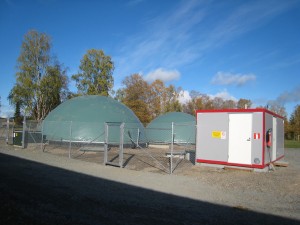 Electricity generated from renewable energy sources contributes more than one quarter of the EU-28’s gross electricity consumption. Although hydropower remains the single largest source for renewable electricity generation, electricity produced from decentralized and fluctuating sources like wind and solar rose dramatically in the last ten years and biomass power, which is normally produced by plants with a static power output, increased threefold. The existing energy system was built on a demand oriented, centralized supply structure and power grids aren’t usually capable to export the surplus electricity produced during peak times by wind and solar plants. This is the case in some regions of West Denmark and Northern Germany (namely the Region of Schleswig-Holstein) where some renewable energy generation units are curtailed by the grid operator to provide grid stability. In 2012, 346 GWh of renewable electricity was lost by this feed-in management system in Schleswig-Holstein.
Electricity generated from renewable energy sources contributes more than one quarter of the EU-28’s gross electricity consumption. Although hydropower remains the single largest source for renewable electricity generation, electricity produced from decentralized and fluctuating sources like wind and solar rose dramatically in the last ten years and biomass power, which is normally produced by plants with a static power output, increased threefold. The existing energy system was built on a demand oriented, centralized supply structure and power grids aren’t usually capable to export the surplus electricity produced during peak times by wind and solar plants. This is the case in some regions of West Denmark and Northern Germany (namely the Region of Schleswig-Holstein) where some renewable energy generation units are curtailed by the grid operator to provide grid stability. In 2012, 346 GWh of renewable electricity was lost by this feed-in management system in Schleswig-Holstein.
In this context biogas plants can play a role in achieving a higher integration of renewable electricity in the energy system, as an example by using the surplus electricity generated by local wind and solar plants to convert it into synthetic natural gas. A possible solution for this is to combine anaerobic digestion with the hydrogen technology for renewable energy storage. This approach was studied by the Aalborg University and the Flensburg University of Applied Science, which named this process as dynamic biogas upgrading.The study aimed at proofing the possibility of such a scheme by adopting a three step approach: a feasibility study to assess the potential in Northern Germany, a process simulation to determine the optimal process conditions and finally some lab experiments to test the proposed scheme.
The initial feasibility study assessed a potential of 600 MW available from biogas plants which could use the available surplus electricity generated by wind and solar plants in the region of Schleswig-Holstein, corresponding to a theoretical potential of 961 GWh of utilized electricity, producing 130 mil. m3 per year of synthetic natural gas, which could be supplied to the existing natural gas grid. For the process simulation waste water from a local dairy farm was used to produce biogas in a continuous stirred tank reactor and an anaerobic baffled reactor. Anaerobic digestion was followed by a dynamic process which can run in two states: in the first case the derived biogas can be utilized for combined heat and power production (business as usual), in the second case, the biogas is mixed with hydrogen, so it can be converted into synthetic natural gas (SNG) by a chemical process called Sabatier process. The CO2 fraction of the biogas is used as carbon source and converted into methane by combining it with the hydrogen produced by electrolysis using the surplus electricity, generated by the existing renewable energy systems. By switching between conventional CHP generation and SNG production, a dynamic multi-purpose process is established and the biogas plants can be used to provide positive and negative control power for flexible renewable energy generation from biomass. By using waste streams from industry in novel biogas concepts, an integration between the biomass sector, the industry and the energy sector is possible.
The results from all studies and the experimental trials clearly indicated that dynamic biogas upgrading is a feasible solution for the integration of renewable energy from wind, biomass and solar into the existing energy system. For a sustainable biogas production, local waste streams can be utilized by new process designs. This approach opens new opportunities for the biogas sector to provide not only combined heat and power, but also other smart solutions for energy storage, waste treatment and power balance.
This post is based on a paper by Jürgensen L., Ehimen E.A., Born J., Holm-Nielsen J.B. from Aalborg University (Denmark) and Flensburg University of Applied Science (Germany) presented at the 23rd European Biomass Conference and Exhibition. The full paper is published in the conference proceedings and is available by clicking below.


